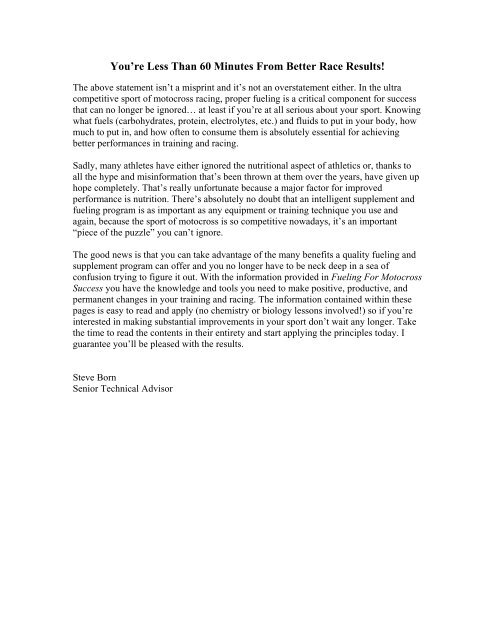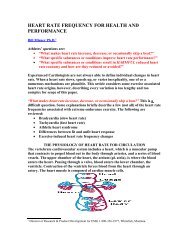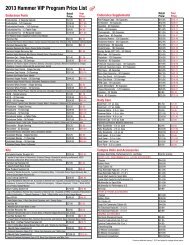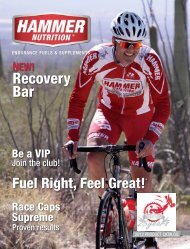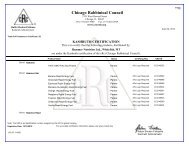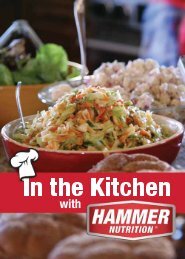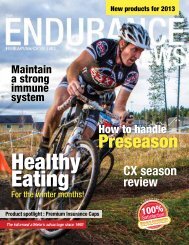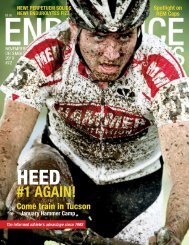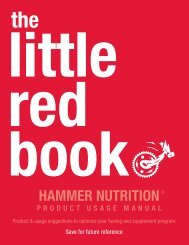Fueling For Motocross Success - Hammer Nutrition
Fueling For Motocross Success - Hammer Nutrition
Fueling For Motocross Success - Hammer Nutrition
Create successful ePaper yourself
Turn your PDF publications into a flip-book with our unique Google optimized e-Paper software.
You’re Less Than 60 Minutes From Better Race Results!<br />
The above statement isn’t a misprint and it’s not an overstatement either. In the ultra<br />
competitive sport of motocross racing, proper fueling is a critical component for success<br />
that can no longer be ignored… at least if you’re at all serious about your sport. Knowing<br />
what fuels (carbohydrates, protein, electrolytes, etc.) and fluids to put in your body, how<br />
much to put in, and how often to consume them is absolutely essential for achieving<br />
better performances in training and racing.<br />
Sadly, many athletes have either ignored the nutritional aspect of athletics or, thanks to<br />
all the hype and misinformation that’s been thrown at them over the years, have given up<br />
hope completely. That’s really unfortunate because a major factor for improved<br />
performance is nutrition. There’s absolutely no doubt that an intelligent supplement and<br />
fueling program is as important as any equipment or training technique you use and<br />
again, because the sport of motocross is so competitive nowadays, it’s an important<br />
“piece of the puzzle” you can’t ignore.<br />
The good news is that you can take advantage of the many benefits a quality fueling and<br />
supplement program can offer and you no longer have to be neck deep in a sea of<br />
confusion trying to figure it out. With the information provided in <strong>Fueling</strong> <strong>For</strong> <strong>Motocross</strong><br />
<strong>Success</strong> you have the knowledge and tools you need to make positive, productive, and<br />
permanent changes in your training and racing. The information contained within these<br />
pages is easy to read and apply (no chemistry or biology lessons involved!) so if you’re<br />
interested in making substantial improvements in your sport don’t wait any longer. Take<br />
the time to read the contents in their entirety and start applying the principles today. I<br />
guarantee you’ll be pleased with the results.<br />
Steve Born<br />
Senior Technical Advisor
FUELING FOR MOTOCROSS SUCCESS<br />
Table of Contents<br />
• Eight <strong>Nutrition</strong>al Mistakes to Avoid<br />
• FUELS – What To Consume <strong>For</strong> Optimal Performance<br />
• HYDRATION – What You Need to Know<br />
• RECOVERY – Do It Right and Reap the Rewards<br />
• SUPPLEMENTATION – Your Extra Edge<br />
• <strong>Hammer</strong> <strong>Nutrition</strong> Fuels – MX Sample Starter Kit<br />
• <strong>Hammer</strong> <strong>Nutrition</strong> Fuels – MX Pro Starter Kit
FUELS – What To Consume <strong>For</strong> Optimal Performance<br />
What you put in your body in terms of fuel will greatly determine the energy you get out of it. Sounds pretty simple but<br />
that’s really the way it is. Think of it this way. When you put lower-quality/lower-grade gasoline in the tank of your<br />
motorcycle it doesn’t matter how great the engine may be, it’s just not going to run as well! The same concept is true<br />
with the body. You can have the best equipment in the world and you can train like a madman but if you don’t put the<br />
right amounts of the proper fuel in your body you’re never going to get the full value out of either of those things –<br />
equipment or training.<br />
So if you’re ready to take your training and racing to a higher level this article is really important for you because (a)<br />
it’ll explain what to avoid and why, and (b) it’ll give you the information you need regarding the <strong>Hammer</strong> <strong>Nutrition</strong><br />
fuels – <strong>Hammer</strong> Gel, HEED, Endurolytes, and Recoverite – the “premium fuels” for your body. First, let’s look at what<br />
you need to avoid…<br />
SIMPLE SUGARS – Avoid the “OSE’s”!<br />
“What are the OSE’s” you might ask. That’s the last part of the names of sugars that, if you care at all about your<br />
athletic performance and your health, you’ll avoid like the plague. The sugars I’m referring to are those 1- and 2-chain<br />
carbohydrates (a.k.a. “simple sugars”) known as glucose, sucrose, fructose, and dextrose. Avoid these as much as<br />
possible, both in your daily diet and in the fuels you consume, and you’ll be a healthier, better performing athlete.<br />
You’ve heard the phrase “garbage in, garbage out,” right Guess what—simple sugars are garbage when it comes to<br />
fueling your body during exercise and they’re downright hazardous for your health. Space limitations prevent me from<br />
going into greater detail about the health hazards of refined sugar but I highly recommend you read the article 113<br />
Ways Sugar Can Ruin Your Health, which you’ll find in the Endurance Library section of the <strong>Hammer</strong> <strong>Nutrition</strong> web<br />
site (www.e-caps.com). It’ll forever change your mind about the “innocence” of sugar.<br />
<strong>For</strong> now, let’s look at why these simple sugars should have absolutely NO part in your fuel:<br />
1.) When ingested, simple sugars cause your blood sugar levels to rise and fall dramatically. It’s a “flash and crash”<br />
type of energy that you definitely don’t want to experience unless, that is, you enjoy experiencing symptoms such as<br />
depression, malaise, and premature fatigue. <strong>For</strong> top performance you want consistent, reliable energy, not this “roller<br />
coaster,” up and down, wildly fluctuating energy.<br />
2.) When you use a fuel that contains any simple sugars it must be mixed and consumed in very weak (6-8%) solutions<br />
in order to match your body fluid chemistry and be digested with any efficiency. Now, you might think that’s not a big<br />
deal but at that weak of concentration you’re getting maybe 80-100 calories an hour, which is definitely not going to<br />
satisfy your body’s energy demands. But before you think of making a double or triple strength bottle of that sugarladen<br />
sports drink, think again. If you do that in the hopes of obtaining more calories, you’ll only end up with (at the<br />
very least) a raging case of sour stomach because you’ve made that drink too concentrated. It doesn’t come close to<br />
matching your body fluids, and it’ll literally be fermenting in your stomach. Yuck!<br />
Bottom line: Simple sugars are a very inefficient fuel source and using them to fuel your body is like trying to heat<br />
your house by burning newspapers in your stove. You get a fast heat, but it burns out quickly, and you have to<br />
continually feed the fire. Not good! Complex carbohydrates, on the other hand, are similar to putting a nice big log on<br />
the fire in that they burn longer and more evenly, with the decline in “heat” (energy levels) being much more gradual.<br />
That’s why no <strong>Hammer</strong> <strong>Nutrition</strong> fuel ever contains any added simple sugars. Avoid fuels that contain any of the<br />
“ose’s” and use complex carbohydrates only to fuel your body during exercise. Your body will thank you and your<br />
performance will be your proof.<br />
Now that you know that <strong>Hammer</strong> <strong>Nutrition</strong> fuels are the ones that will work with your body, not against it, here are the<br />
ones I think would benefit you the most:<br />
Calorie Fuels<br />
<strong>Hammer</strong> Gel – Our original fuel, an athletic mainstay for over 15 years, <strong>Hammer</strong> Gel is energy fuel in a pancake syrup<br />
consistency. You can use <strong>Hammer</strong> Gel as all or part of a pre-race meal, to fend off hunger immediately before a<br />
workout or race, and to provide all your energy needs during a workout or race. <strong>Hammer</strong> Gel can be used “as is” from<br />
the single serving pouches, “in bulk” from the <strong>Hammer</strong> Gel flask, or it can be mixed in your water bottle. Eight great<br />
tasting flavors give you plenty of variety in your fueling “menu”.<br />
HEED – HEED is <strong>Hammer</strong> <strong>Nutrition</strong>’s powdered drink mix. Unlike the majority of the drinks available to athletes,<br />
HEED isn’t loaded with any refined sugar or other garbage (artificial colors or sweeteners) that you don’t need. HEED<br />
also contains a full-spectrum electrolyte profile that will help prevent cramping. HEED comes in mandarin orange and<br />
lemon lime flavors (an unflavored version is due soon!) and all are very subtle tasting. That means that your taste buds<br />
won’t be assaulted with a too-sweet taste and you won’t have to choke it down.<br />
Either way, with <strong>Hammer</strong> Gel or HEED, you’re giving your body exactly what it needs to maintain optimal energy<br />
production from beginning to end.
Suggested Amounts by Body Weight*<br />
HAMMER GEL<br />
HEED<br />
• Up to 120 pounds: up to 2 servings/hour<br />
• 120-155 pounds: up to 2.5 servings/hour<br />
• 155-190 pounds: up to 3 servings/hour<br />
• 190+ pounds: up to 3 to 3.5 servings/hour<br />
• Up to 120 pounds: up to 1.5 scoops/hour<br />
• 120-155 pounds: up to 2.5 scoops/hour<br />
• 155-190 pounds: up to 2.75 scoops/hour<br />
• 190+ pounds: up to 3 scoops/hour<br />
*These are estimated doses. Each athlete should determine in training, under a variety of conditions, their personal<br />
optimum.<br />
Electrolytes<br />
Endurolytes – A full-spectrum, rapidly assimilated electrolyte supplement is as important to your fueling as the water<br />
you drink and the calories you eat. While the above fuels provide the calories your body needs to make energy (the<br />
body’s “gasoline”), electrolytes can be thought of as the “motor oil” for the body, providing it with the essential<br />
minerals it needs to maintain the optimal performance of many important functions, such as muscular contraction.<br />
Far too many athletes forget to replenish electrolytes consistently, or they mistake sodium or salt intake for true<br />
electrolyte replenishment. Sodium chloride (salt) is indeed an important component of electrolyte replenishment, but it<br />
does not fulfill the entire requirement. A satisfactory electrolyte replenishment product needs to include sodium,<br />
chloride, calcium, magnesium, and potassium as all these minerals play key roles in the maintenance of these important<br />
body functions. Endurolytes is that product, and you will search in vain to find another like it on the market.<br />
Unlike calorie and fluid assimilation rates, which remain fairly constant from athlete to athlete, electrolyte expenditure<br />
(and thus replenishment) varies tremendously. Body weight, level of fitness, weather conditions, acclimatization level,<br />
and biological predisposition all greatly affect electrolyte depletion and the need for replenishment. That’s why the<br />
hourly Endurolytes dose can range from 1-6 capsules an hour. That being said, a good starting dose to consider is:<br />
• Lighter weight athletes: 1-2 capsules/hour<br />
• Medium weight athletes: 2-3 capsules/hour<br />
• Larger athletes: 4-6 capsules/hour<br />
Remember though, these are only suggested starting doses and the amount you need may be different, and may vary<br />
from hour to hour.<br />
Recovery Drink<br />
Recoverite – The delicious all-in-one recovery drink with each serving (two scoops) supplying your body with 30<br />
grams of complex carbohydrates, 10 grams of whey protein isolate, and three grams of immune system-boosting<br />
glutamine. After tough training sessions or races your body is begging you to refill it with premium fuel as soon as<br />
possible. If you do that you recover faster and your immune system stays strong… it’s as simple as that. Recoverite is<br />
the super easy way to give your body exactly what it wants. Mix a couple of scoops in 12-16 ounces of cold water,<br />
drink, and you’re done. Do this after each of your workouts, even if you’re doing more than one a day. If you can’t sit<br />
down to a full meal within the next couple hours have another 2-scoop serving of Recoverite.<br />
SUMMARY<br />
What kind of food/fuel you put in your body definitely matters because it determines the kind of energy you’re going to<br />
get out of it. Nowadays, the competition is too strong and the difference between first and last is so narrow… you just<br />
can’t “wing it” and hope that you’ll get by on any old fuel. No, you have to make conscious choices in what you put in<br />
your body if you hope to get the most out of your training session and achieve success come race day. Getting your fuel<br />
dialed in is as important as any piece of equipment you use or any training techniques you employ, so definitely don’t<br />
blow it off. <strong>For</strong>tunately, <strong>Hammer</strong> <strong>Nutrition</strong> takes the guesswork out of this oft-neglected area of athletic performance<br />
by providing you with the fuels your body craves. With the <strong>Hammer</strong> fuels your pre, during, and post-workout & racing<br />
needs are perfectly and completely met. This allows you to focus on your training session or race, not on whether or not<br />
your fuel is going to let you down or make you sick.
HYDRATION – What You Need to Know<br />
I won’t go into a long dissertation about how your body’s internal cooling system works but I can tell you that it<br />
involves a variety of complex mechanisms all designed to support the body during hot weather conditions, keeping it<br />
cool and protecting the vital organs. By far, the most important part of your body’s cooling system, accounting on<br />
average for about 75% of all cooling, is your ability to produce and excrete sweat.<br />
Weather conditions greatly affect sweat production and cooling effectiveness. In cool weather, you get substantial<br />
cooling from the heat that escapes directly from your skin. As the temperature increases, you gradually rely more on<br />
evaporation. On hot days, with little difference between skin surface and ambient temperatures, your skin surface<br />
provides only negligible convective cooling, and you need to sweat more to maintain a safe internal core temperature.<br />
At 95ºF or above, you lose no heat at all from your skin; you actually start to absorb it. Evaporative cooling must do all<br />
the work.<br />
Humidity is the other major factor that affects sweat. On humid days, sweat evaporates more slowly because the<br />
atmosphere is already saturated with water vapor, which drastically slows down the evaporation rate. The sweat<br />
accumulates on your skin and soaks your clothes, but you don’t get any cooling from it because it’s not evaporating.<br />
Soaking, dripping sweat may give you a psychological boost, but it has no physical efficacy to cool; sweat must<br />
evaporate to remove heat. On days when it’s both hot and humid Well, you don’t need to read about what’s going to<br />
happen when you exercise in those conditions. You do need to know that under the worst of conditions you can<br />
produce up to three liters of sweat in an hour of strenuous exercise, but your body can only absorb about one liter from<br />
fluid consumption. Yes, this will cause problems before long, and we will discuss that issue below.<br />
What Happens When the Coolant Runs Low<br />
Just like a car, your body must dissipate the excess heat generated from burning fuel. However, unlike an automobile,<br />
your body’s coolant isn’t in a sealed internal system; you use it once and then it’s gone and needs to be replaced.<br />
Unfortunately, we don’t come with built-in gauges or indicators that tell us just how much coolant we have left in our<br />
system. We can’t run a dipstick down our gullet and get a reading that says, "Add a quart." We do have some<br />
physiological signs, but they function at the “Warning-Danger!” level, too late to maintain optimal performance. <strong>For</strong><br />
instance, by the time you feel thirsty, you could have a 2% body-weight water loss, already into the impairment zone.<br />
The chart below shows what happens to human performance at each percent of weight loss. By weight loss, we mean<br />
the percentage of your body weight at the start of exercise that you have lost via sweat. If you go out for a ride at 160<br />
pounds and weigh in a few hours later at 154, you’ve lost almost 4% of your body weight.<br />
Symptoms by Percent Body Weight Water Loss:<br />
PERCENT WATER LOST --------- SYMPTOMS<br />
0% --- none, optimal performance, normal heat regulation<br />
1% --- thirst stimulated, heat regulation during exercise altered, performance declines<br />
2% --- further decrease in heat regulation, hinders performance, increased thirst<br />
3% --- more of the same (worsening performance)<br />
4% --- exercise performance cut by 20 - 30%<br />
5% --- headache, irritability, "spaced-out" feeling, fatigue<br />
6% --- weakness, severe loss of thermoregulation<br />
7% --- collapse likely unless exercise stops<br />
10% -- comatose<br />
11% -- death likely<br />
[<strong>Nutrition</strong> for Cyclists, Grandjean & Ruud, Clinics in Sports Med. Vol 13(1);235-246. Jan 1994]<br />
Over-hydration – Too Much Of A Good Thing<br />
So now you’re probably thinking, “Whoa, I’ve got to drink a lot of fluid!” Well, that’s true to some extent but while not<br />
drinking enough fluids (dehydrating) can cause some problems, drinking too much (over-hydrating) can cause just as<br />
many problems, perhaps more, some with devastating consequences.<br />
In the past several months there have been a lot of articles written about the dangers associated with over-hydration,<br />
which again, is simply drinking more fluids than your body can handle. In fact, there have been numerous athletes<br />
(runners, mostly) who drank so much fluid in hot weather that they ended up in the hospital. Some have even died (yep,<br />
died!) and it’s all due to over-hydration. With that in mind, we all know that racing motocross in the heat is more<br />
challenging than in other sports like marathon running. You don’t have the luxury of being able to race in a tank top,<br />
shorts and running shoes the way runners do. With all of your riding gear and helmet, staying hydrated and avoiding<br />
overheating is very difficult. So what do you do<br />
Well, most of the advise you’ve heard before about hydrating in the heat probably sounded something like this: “drink,<br />
drink and drink some more” or “drink even when you’re not thirsty” or “drink to replace” – <strong>For</strong>get all of this, it’s just<br />
plain wrong. Although well intentioned, this advice is inaccurate at best and can be downright dangerous at worst. At<br />
the races, over-hydration and the electrolyte depletion that goes with it causes you to feel tired, lethargic, queasy, and<br />
experience muscle cramps and many other symptoms that many have inaccurately been thought to be caused by<br />
dehydration. So needless to say, you have to be very conscientious about how much fluid you consume since too much<br />
is just as bad or worse as too little.<br />
Regardless of how hot it is, even when the heat index is well over 100, you must resist the urge to drink excessive<br />
amounts. The majority of athletes under most conditions will satisfy their hydration needs with a fluid intake in the 20-
28-ounce per hour range (roughly the size of the typical small to large water bottle. We’ve provided a weight-adjusted<br />
chart below that will provide a gauge as to the maximal amounts of fluids you can consider consuming hourly. Keep in<br />
mind though, that these are suggested maximal amounts and that your requirements may be less. <strong>For</strong> most athletes,<br />
fluid intake over 30 ounces hourly really increases the potential for serious performance and health problems. Keep that<br />
in mind before you gulp down excessive amounts of fluid. If you override your internal mechanisms, you’ll find out the<br />
hard way how your body deals with excess water intake during intense exercise.<br />
Tips <strong>For</strong> Proper Hydration And Top Performance In The Heat<br />
• Treat each moto as a 1-hour exercise period, even though it may only last 15-20 minutes – Sip 10-28 ounces<br />
of HEED or water after each moto. See chart below.<br />
• To cool off (which helps lower your core temperature) take a wet towel out of the ice chest and put it over<br />
your head and shoulders. If you have enough time between motos, strip out of your gear and jump in the<br />
creek or sit in the shade with your wet towel.<br />
• Avoid foods and fuels that contain simple sugars (glucose, fructose, dextrose, sucrose) as they require more<br />
fluids and electrolytes for digestive purposes. Also avoid carbonated drinks, as the gas inhibits absorption.<br />
• Use caffeine with caution. Used properly and sparingly, caffeine has some benefits. It does, however, also act<br />
as a diuretic, which may deplete fluid stores more rapidly.<br />
• Take Endurolytes, which will supply the important electrolytic minerals your body needs to function<br />
optimally and to prevent cramping.<br />
• Know the symptoms of over-hydration and dehydration. Stop immediately if you feel lightheaded, queasy, or<br />
get the dry chills. No race or training is worth compromising your health.<br />
Maximal Fluid Intake Chart<br />
Weight in pounds max fluid ounces per hour<br />
60 10-12<br />
80 13-15<br />
100 16-18<br />
120 20-22<br />
140 23-24<br />
150 25-27<br />
165 28-30<br />
180 30-32<br />
200 33-36<br />
SUMMARY<br />
Water is the most important component of your fueling regimen, more than any fuel or supplement. It comprises 60%<br />
of your body weight, and should be the number one concern on your intake list. Dehydration and/or over-hydration is a<br />
common problem that plagues far too many athletes, some with severe consequences. Armed with the guidelines<br />
contained in this article, along with practice and testing in training, your performance and health need not suffer.<br />
Instead, you’ll be ahead of the vast majority of athletes who continue to make the same mistakes over and over again.
RECOVERY – Do It Right and Reap the Rewards<br />
Most of the time the first thing we want to do after a tough workout is get out of our dirty, sweaty workout gear and<br />
take a shower. After that, the next thing we usually end up doing is heading straight for the couch for some well-earned<br />
R&R. Does that scenario sound familiar to you too If so, you’re not alone but in all honesty it’s not the best thing you<br />
can do to get the most out of your workouts and “prep” your body for your upcoming races. In fact, I believe that one<br />
of the areas that athletes tend to neglect the most is in regards to recovery, specifically the refueling of the body as soon<br />
as possible after each and every workout.<br />
Are you guilty of this as well If so, that’s really unfortunate because it’s absolutely one of the most important things<br />
that you can do to improve your chances of success come race day. In fact, I honestly believe that properly refueling<br />
your body immediately after all your training sessions is as important as anything you did in the actual workout. When<br />
you give your body what it needs as soon as possible after exercise (and that means before hitting the shower and<br />
before getting horizontal on the sofa) it will respond wonderfully and you’ll benefit tremendously. You recover and<br />
rebuild faster, and your body is able to store more and more of a premium, ready-to-use fuel known as muscle<br />
glycogen. The bottom line is that you can really give yourself a major advantage come race day if you’ll take the time<br />
to put some quality fuel back in your body as soon as possible after all your workouts leading up to the race.<br />
If you’re at all serious about performing better in your racing AND staying healthier, here’s a saying you need to live<br />
by – “Once you’ve finished training, you’re still not finished training!” Here’s what I mean: You’ve got to pay as<br />
much attention to recovery as you do to your workout if you expect to reap the benefits of hard training. In other words,<br />
how well you recover today will be a huge factor in how well you perform tomorrow.<br />
And you know what It’s really simple to maximize your recovery and reap all the rewards that come from that. Here<br />
are the two primary things you need to do:<br />
1.) Consume 30-60 grams of quality carbohydrates within the first 30 minutes after each workout<br />
2.) Consume 10-30 grams protein, preferably whey protein, during that time as well<br />
Let’s take a brief look at each of those components, beginning with carbohydrate replenishment. When you begin a<br />
workout or race the first fuel your body will use is stored carbohydrate, which is known as muscle glycogen. There is a<br />
finite amount of this premium fuel available in your body but its importance can’t be overstated. Quite simply, the<br />
athlete who has more of this readily available fuel in their body has a definite advantage and to have a good race or<br />
workout, you need to start with a full load of muscle-stored glycogen.<br />
The question is: How can you get your body to store as much of it as it possibly can The first way is through training,<br />
which increases both muscle glycogen storage capacity and how efficiently your body uses it. The second way is to<br />
replenish the body with carbohydrates as soon as possible after exercise, which is when the body is most receptive to<br />
taking those carbs, converting them into glycogen, and storing them in the muscles. Along with insulin, an enzyme<br />
known as glycogen synthase drives carbohydrates into glycogen stores and protein into muscle cells. Unfortunately, the<br />
“life span” of glycogen synthase is relatively short, peaking in the 0-30 minutes after exercise then declining<br />
substantially for the next 90 minutes. Needless to say, to store as much glycogen as possible, it’s important to take<br />
advantage of the glycogen synthase enzyme when it’s most active.<br />
Here’s why all this is so important to you as an athlete:<br />
1. The less-fit athlete, and the one who HAS NOT been putting carbohydrates back in their body shortly after<br />
exercise, has very limited amounts of muscle glycogen available, perhaps as little as 10-15 minutes worth.<br />
2. The fit athlete, and the one who HAS been consistently refueling their body with carbohydrates immediately<br />
after exercise, can build up a nice 60-90 minute reservoir of this premium, ready-to-use fuel. Which would<br />
you rather have when the gate drops – a measly 15 minutes of on-board, ready-to-use fuel or a full 90<br />
minutes worth The answer should be pretty obvious.<br />
RULE #1 – As soon as possible after you finish your workout, before you get into the<br />
shower or before you get horizontal, consume approximately 30-60 grams of high quality<br />
complex carbohydrates.<br />
Now let’s look at protein. You see, while carbohydrate intake promotes many aspects of post-exercise recovery, it can’t<br />
do the job alone; you need protein as well. The primary reason for consuming protein is that it provides the raw<br />
materials needed to rebuild stressed muscles. Protein also plays a key role in how well the body stores glycogen.<br />
Finally, protein is crucial for maintaining a strong immune system.<br />
Of all the protein sources available whey protein is considered the ideal protein for recovery. It’s the fastest acting<br />
protein source and contains the highest percentage of essential amino acids, the protein “building blocks” that your<br />
body does not manufacture and must obtain from dietary sources. Whey protein is also rich in other amino acids that<br />
have a direct impact on strengthening your immune system.<br />
So for rebuilding the muscle tissue, for maximizing how much glycogen your body can store, and to build a strong<br />
immune system don’t forget to consume protein, preferably whey protein, after your workouts.
RULE #2 – After your workouts, consume 10-30 grams of protein, preferably whey, along<br />
with your complex carbohydrates.<br />
You can use high quality solid food to refuel your body after your workouts. Whole grain breads, pasta, fruits, and<br />
cereal are all good carbohydrate choices. <strong>For</strong> protein, you can eat most any kind of meat – chicken, beef, fish – as well<br />
as cheese and eggs. Just as an example, a PB&J sandwich – using organic bread, organic fruit spread, and healthy<br />
peanut butter (the kind where the oil floats on top of the jar) – is a pretty darn good post-workout recovery meal. A<br />
bagel, a piece of fruit, and a serving of cottage cheese is another good post-workout meal choice.<br />
If you’re unable or uninterested in making a full-fledged meal after your workout, consider using Recoverite, a<br />
delicious and easy to make carb/protein powdered drink mix. Recoverite contains an ideal 3:1 ratio of quality complex<br />
carbohydrates and whey protein so it takes the guesswork out of post-workout recovery. Mix a couple of scoops with<br />
water, drink, you’re done… simple. You’ve just put the best “finishing touches” on your workout that you possibly<br />
could, and you’ve given your body a great head start on tomorrow’s workout.<br />
SUMMARY<br />
Athletic performance improvement depends on successive, incremental exercise sessions that stimulate muscular and<br />
cardiovascular adaptation followed by a recovery period in which the body rebuilds itself slightly more fit than before.<br />
Thus, the real gain of exercise occurs during recovery, but only in the presence of adequate rest and optimal<br />
nutritional support. Remember, how well you recover today will greatly determine your performance tomorrow.<br />
Athletes who attend to the recovery process as much as they do to active training are way ahead of the game and will<br />
no doubt enjoy increased performance.
SUPPLEMENTATION – Your Extra Edge<br />
Supplements aren’t thought about too often with athletes and I think there are two reasons for that. First, athletes are<br />
mistakenly told that “you can obtain all the nutrients from your diet.” Second, most athletes are simply overwhelmed<br />
by the tremendous number of products out there and the equally tremendous amount of hype.<br />
Here are my answers to both of those points:<br />
1.) If you’re a competitive athlete or even just a fairly active person, your diet, no matter how good you think it<br />
might be, is simply not going to provide you with enough of the vitamins and minerals your body needs for<br />
the optimal performance of literally hundreds of important functions. Dr. Bill Misner states, "Athletes today<br />
ingest only 11% of the organic nutrients from their food sources that the athletes of the 1940’s enjoyed.” That<br />
means exactly what you think it does: Due to a variety of factors (farming techniques, the use of commercial<br />
fertilizers, pesticides, herbicides, commercial ripening, harvesting, shipping, storing, and processing<br />
practices) the food you’re eating most likely has very minimal amounts of nutrients left in them.<br />
Also, you’ve heard of the Recommended Daily Allowance (RDA), right Well, I believe that standard is very<br />
much outdated and is one that never took into account the particular needs of athletes in the first place. My<br />
belief is confirmed from one well-known sports nutritionist who states, " If you use the RDAs to plan your<br />
nutrition, you will never, never reach your athletic potential."<br />
Bottom line: It’s a well-accepted truth that athletes use up more nutrients than couch potatoes do. In other words, the<br />
more active you are, the more nutrients (vitamins, minerals, enzymes, co-enzymes, etc) you’re going through.<br />
Unfortunately, our food supply just doesn’t contain what it used to. And if these nutrients aren’t in the soil, they’re not<br />
in the foods and if they’re not in the foods, they’re not in your body. So while it’s important to eat as healthy as<br />
possible (you know the drill – lots of fresh fruits and vegetables, etc) your diet’s not going to take care of all your<br />
needs.<br />
2.) Yes, the supplement industry can sometimes be very difficult for a consumer to figure out. Just as an<br />
example, walk into any health food store and you’ll be overwhelmed with the number of products available to<br />
athletes. Then, check out most of these company’s web sites and you’ll be blown away by the hype that<br />
surrounds their products (“pack on 10 lbs of lean muscle mass in days!” and other similar nonsense). Look,<br />
there’s no doubt that supplementation is really important if you’re at all interested in improving your athletic<br />
performance and health. You just need to get past the hype and empty promises that come with all of the<br />
“here today, gone tomorrow” companies and utilize products that come from companies with a solid<br />
reputation and a long history of good ethics. And that’s where we at <strong>Hammer</strong> <strong>Nutrition</strong> can help.<br />
Bottom line: An intelligent supplement program can yield tremendous benefits for you. Your performance on the bike<br />
and your overall health can be greatly improved by the consistent use of the right supplements. When you use any of<br />
the E-CAPS supplements you’re going with a company that has a sterling reputation in the industry and one where you<br />
can have complete confidence. We guarantee that you will notice a substantial difference when you use our products.<br />
That’s right, guaranteed.<br />
SUPPLEMENT SELECTION<br />
OK, so now you’re thinking that taking supplements is a good idea. Which ones to use though Well, the E-CAPS<br />
product line consists of over a dozen different supplements but I’ve boiled it down to a mere two. That’s right, I believe<br />
that there are two supplements that, if you’ll take them consistently, will make a major difference in both your<br />
performance in training and racing, and in your general health as well. These are the two products that I believe provide<br />
the widest range of benefits for you, helping you to get the very most out of every minute you put into your training<br />
while also protecting and strengthening your immune system. And both are really important. Yes, you want to have an<br />
edge on your opponents come race day and both products will help you achieve that. But they’re also vital for your<br />
general health, which you should be very much interested in. You see, if you’re sick you can’t train, and if you can’t<br />
train you can’t improve. And not improving means you’re going to be left behind, taking in someone else’s dust instead<br />
of vice versa. However, with these two products you’ll have what you need to help maintain a strong immune system,<br />
which will definitely make a difference in all your workouts and races.<br />
The first product is called Premium Insurance Caps and this is your multivitamin/mineral supplement, the product<br />
that will cover your basic nutrient needs. Remember, you’re going to be depleting your body of nutrients at a much<br />
higher rate than sedentary people do, which is why this product is so perfect. It contains optimal amounts of vitamins,<br />
minerals, enzymes, and healthy “super foods,” levels you won’t find in the typical store-bought vitamin. Premium<br />
Insurance Caps doesn’t replace your efforts in eating healthy but it definitely “bridges the gap” between what you<br />
should be obtaining in your diet versus what you’re actually getting.<br />
SUGGESTED DOSE<br />
Workout Days: Take a full packet (7 capsules) in divided doses, with 4 of those capsules being consumed with your<br />
post-workout meal.<br />
Days Off: Take 2 capsules with breakfast, 2 with lunch or dinner.<br />
Race Day: Take 3 capsules with breakfast, 4 capsules after your last moto, with food.<br />
*************************************
The second product is called Race Caps Supreme. Think of this product as your body’s spark plugs, the nutrients that<br />
are necessary to convert your food and oxygen into energy. When you take Race Caps Supreme you’ll be providing<br />
your body with the specific nutrients that will increase your endurance. You won’t be doing it “artificially” with<br />
stimulants, but with the key subtrates (“spark plugs”) that your body needs to make energy more consistently and<br />
efficiently. In addition, the primary nutrients in Race Caps Supreme are also excellent antioxidants, which will work<br />
perfectly with Premium Insurance Caps in protecting your immune system. This product has been a staple in the<br />
supplement regimen of thousands of athletes for nearly two decades and when you take it consistently you’ll notice the<br />
following:<br />
• You won’t be as sore and tired from your workouts<br />
• You’ll have more energy during the day<br />
• You’ll be able to increase the workload and intensity of your workouts<br />
• You’ll notice your muscles performing better, with much less burning than before<br />
• You’ll recover from your workouts faster<br />
SUGGESTED DOSE<br />
Workout Days: Take 1 capsule before your workout and 1 capsule afterwards. If you’re going to be training for more<br />
than two hours, double the dose (2 before, 2 after). On days off take 1 capsule with breakfast and 1 with lunch.<br />
Days Off: Take 1 capsule with breakfast, 1 with lunch<br />
Race Day: Take 2 capsules 30-45 minutes before each moto. Take 2 capsules after your last moto, with food.<br />
SUMMARY<br />
Supplements are just that… they supplement a good diet and provide ideal amounts of important nutrients that you<br />
can’t obtain even in the best of diets. Remember, supplements don’t replace a good diet, nor are they a substitute for<br />
consistent, high quality training and adequate recovery. You need to make sure those two things – a good diet and a<br />
quality training/recovery plan – are already in place. When they are, supplements can definitely help take your<br />
performance to the next level, allowing you to make increases in the volume and quality of your training, without your<br />
immune system taking such a hit. Translated, that means better performance come race day and better overall health.
<strong>Hammer</strong> <strong>Nutrition</strong> Fuels - MX Sample Starter Kit<br />
<strong>For</strong> your training sessions and races you need three things – fluids (to keep you hydrated), calories (for energy production<br />
during your workouts and for recovery after your workouts), and electrolytes (to prevent cramping and optimize many<br />
important body functions). You provide the water; we’ll take care of the rest. <strong>Hammer</strong> Gel and/or HEED are your “during<br />
exercise” calorie fuels, Endurolytes will take care of your electrolyte requirements, and Recoverite will fulfill your body’s<br />
recovery needs.<br />
FOR WORKOUTS – 90 minutes or less<br />
Use one of the following two options:<br />
• 15-30 minutes prior to workout – Take 1-3 Endurolytes (lean towards the higher amount if the weather is hot)<br />
• 15-30 minutes prior to workout – Consume 1 serving of <strong>Hammer</strong> Gel with water<br />
• During workout – Drink 20-28 ounces of water hourly<br />
OR:<br />
• 15-30 minutes prior to workout – Take 1 Endurolytes<br />
• During workout – Consume 1-2 scoops of HEED mixed in 20-28 ounces of water<br />
After Workouts<br />
• 2 scoops of Recoverite mixed in 12-16 ounces of water. Drink immediately after completing workout session.<br />
----------------------------------------------------------------------------------------------------------------------------------------<br />
FOR WORKOUTS - 90 minutes or longer<br />
Use one of the following two options:<br />
• 15-30 minutes prior to workout – Take 1-3 Endurolytes<br />
• 15-30 minutes prior to workout – Consume 1 serving of <strong>Hammer</strong> Gel with water<br />
• During workout – Consume 1-3 servings of <strong>Hammer</strong> Gel per hour – See chart below for dosage suggestions<br />
• During workout – Drink 20-28 ounces of water hourly<br />
OR:<br />
• 15-30 minutes prior to workout - Take 1-2 Endurolytes<br />
• During workout – Consume 1-3 scoops of HEED mixed in 20-28 ounces of water every hour – See chart below for<br />
dosage suggestions<br />
After Workouts<br />
• 2-4 scoops of Recoverite in 12-16 ounces of water. Drink immediately after completing workout session.<br />
---------------------------------------------------------------------------------------------------------------------------------<br />
RACE DAY FUELING PLAN<br />
OPTION ONE: Consume a light breakfast (200-400 calories) 3+ hours prior to start of first moto. Take 1-3<br />
Endurolytes with breakfast.<br />
OPTION TWO: If you have a very early race start, skip breakfast (it’s OK… really!) and take 2 servings of <strong>Hammer</strong><br />
Gel + 1-3 Endurolytes 5-15 minutes prior to first moto.<br />
If you have LESS than 60 minutes between motos –<br />
• Take 1-6 Endurolytes (use appropriate amount for your size and weather conditions – see chart below) with water<br />
immediately after each moto<br />
• Consume 1-3 servings of <strong>Hammer</strong> Gel (see chart below) between each moto<br />
• Drink 10-28 ounces of water between each moto<br />
If you have MORE than 60 minutes between motos –<br />
• 1-3 scoops of HEED (see chart below) mixed in 12-28 ounces of water. Drink a bottle every hour.<br />
• If it’s extremely hot take 1-6 Endurolytes (see chart below) with HEED immediately after each moto. Repeat<br />
hourly.<br />
Post-Race <strong>Fueling</strong><br />
• 2-4 scoops of Recoverite in 16-24 ounces of cold water. Start drinking immediately after completing race.<br />
--------------------------------------------------------------------------------------------------------------------------------------------------<br />
USAGE CHART – Dosage Suggestions By Weight or Size<br />
<strong>Hammer</strong> Gel<br />
HEED<br />
Up to 120 pounds: up to 2 servings/hour<br />
Up to 120 pounds: up to 1.5 scoops/hour<br />
120-155 pounds: up to 2.5 servings/hour 120-155 pounds: up to 2.5 scoops/hour<br />
155-190 pounds: up to 3 servings/hour 155-190 pounds: up to 2.75 scoops/hour<br />
190+ pounds: up to 3 to 3.5 servings/hour 190+ pounds: up to 3 scoops/hour<br />
Endurolytes<br />
Lighter athletes: 1-2 capsules/hour Medium weight athletes: 2-3 capsules/hour Larger athletes: 4-6 capsules/hour
<strong>Hammer</strong> <strong>Nutrition</strong> Fuels & E-CAPS Supplements - MX Pro Starter Kit<br />
FOR WORKOUTS – 90 minutes or less<br />
Use one of the following two options:<br />
• 30-60 minutes prior to workouts – Take 1 Race Caps Supreme<br />
• 15-30 minutes prior to workout – Take 1-3 Endurolytes (lean towards the higher amount if the weather is hot)<br />
• 15-30 minutes prior to workout – Consume 1 serving of <strong>Hammer</strong> Gel with water<br />
• During workout – Drink 20-28 ounces of water hourly<br />
OR:<br />
• 30-60 minutes prior to workouts – Take 1 Race Caps Supreme<br />
• 15-30 minutes prior to workout – Take 1 Endurolytes<br />
• During workout – Consume 1-2 scoops of HEED mixed in 20-28 ounces of water<br />
After Workouts<br />
• 2 scoops of Recoverite mixed in 12-16 ounces of water. Drink immediately after completing workout session.<br />
• Take 1 Race Caps Supreme with your Recoverite<br />
• Take 2 Premium Insurance Caps (from the packet of 7) with your Recoverite. Take another 2 capsules later in the<br />
day with food – Total of 4 capsules<br />
----------------------------------------------------------------------------------------------------------------------------------------<br />
FOR WORKOUTS - 90 minutes or longer<br />
Use one of the following two options:<br />
• 30-60 minutes prior to workouts – Take 2 Race Caps Supreme<br />
• 15-30 minutes prior to workout – Take 1-3 Endurolytes<br />
• 15-30 minutes prior to workout – Consume 1 serving of <strong>Hammer</strong> Gel with water<br />
• During workout – Consume 1-3 servings of <strong>Hammer</strong> Gel per hour – See chart below for dosage suggestions<br />
• During workout – Drink 20-28 ounces of water hourly<br />
OR:<br />
• 30-60 minutes prior to workouts – Take 2 Race Caps Supreme<br />
• 15-30 minutes prior to workout - Take 1-2 Endurolytes<br />
• During workout – Consume 1-3 scoops of HEED mixed in 20-28 ounces of water every hour – See chart below for<br />
dosage suggestions<br />
•<br />
After Workouts<br />
• 2 scoops of Recoverite in 12-16 ounces of water. Drink immediately after completing workout session.<br />
• Take 1 Race Caps Supreme with your Recoverite<br />
• Take 4 Premium Insurance Caps (from the packet of 7) with your Recoverite. Take the other 3 capsules later in the<br />
day with food.<br />
---------------------------------------------------------------------------------------------------------------------------------<br />
RACE DAY FUELING PLAN<br />
OPTION ONE: Consume a light breakfast (200-400 calories) 3+ hours prior to start of first moto. Take 2 Race<br />
Caps Supreme + 3 Premium Insurance Caps with breakfast.<br />
OPTION TWO: If you have a very early race start, skip breakfast (it’s OK… really!) and take 2 servings of<br />
<strong>Hammer</strong> Gel + 1-3 Endurolytes + 2 Race Caps Supreme 5-15 minutes prior to first moto.<br />
If you have LESS than 60 minutes between motos –<br />
• Take 1 Race Caps Supreme after each moto<br />
• Take 1-6 Endurolytes (use appropriate amount for your size and weather conditions – see chart below) with water<br />
immediately after each moto<br />
• Consume 1-3 servings of <strong>Hammer</strong> Gel (see chart below) between each moto<br />
• Drink 10-28 ounces of water between each moto<br />
If you have MORE than 60 minutes between motos –<br />
• Take 1 Race Caps Supreme after each moto<br />
• 1-3 scoops of HEED (see chart below) mixed in 12-28 ounces of water. Drink a bottle every hour.<br />
• If it’s extremely hot take 1-6 Endurolytes (see chart below) with HEED immediately after each moto. Repeat<br />
hourly.<br />
Post-Race <strong>Fueling</strong><br />
• 2-4 scoops of Recoverite in 16-24 ounces of cold water. Start drinking immediately after race<br />
• Take 2 Race Caps Supreme with your Recoverite<br />
• Take 4 Premium Insurance Caps (from the packet of 7) with your Recoverite<br />
--------------------------------------------------------------------------------------------------------------------------------------------------<br />
USAGE CHART – Dosage Suggestions By Weight or Size<br />
<strong>Hammer</strong> Gel<br />
HEED<br />
Up to 120 pounds: up to 2 servings/hour<br />
Up to 120 pounds: up to 1.5 scoops/hour<br />
120-155 pounds: up to 2.5 servings/hour 120-155 pounds: up to 2.5 scoops/hour<br />
155-190 pounds: up to 3 servings/hour 155-190 pounds: up to 2.75 scoops/hour<br />
190+ pounds: up to 3 to 3.5 servings/hour 190+ pounds: up to 3 scoops/hour<br />
Endurolytes<br />
Lighter athletes: 1-2 capsules/hour Medium weight athletes: 2-3 capsules/hour Larger athletes: 4-6 capsules/hour


